Management Essentials for Health and Safety: Lessons from US Airways Flight 1549
VerifiedAdded on 2023/06/14
|11
|3397
|149
AI Summary
This report focuses on the incident that took place on January 15, 2009, involving US Airways Flight 1549. It discusses decision-making processes, structures at work, bird strike mitigation, crew training, and lessons learned about health and safety.
Contribute Materials
Your contribution can guide someone’s learning journey. Share your
documents today.
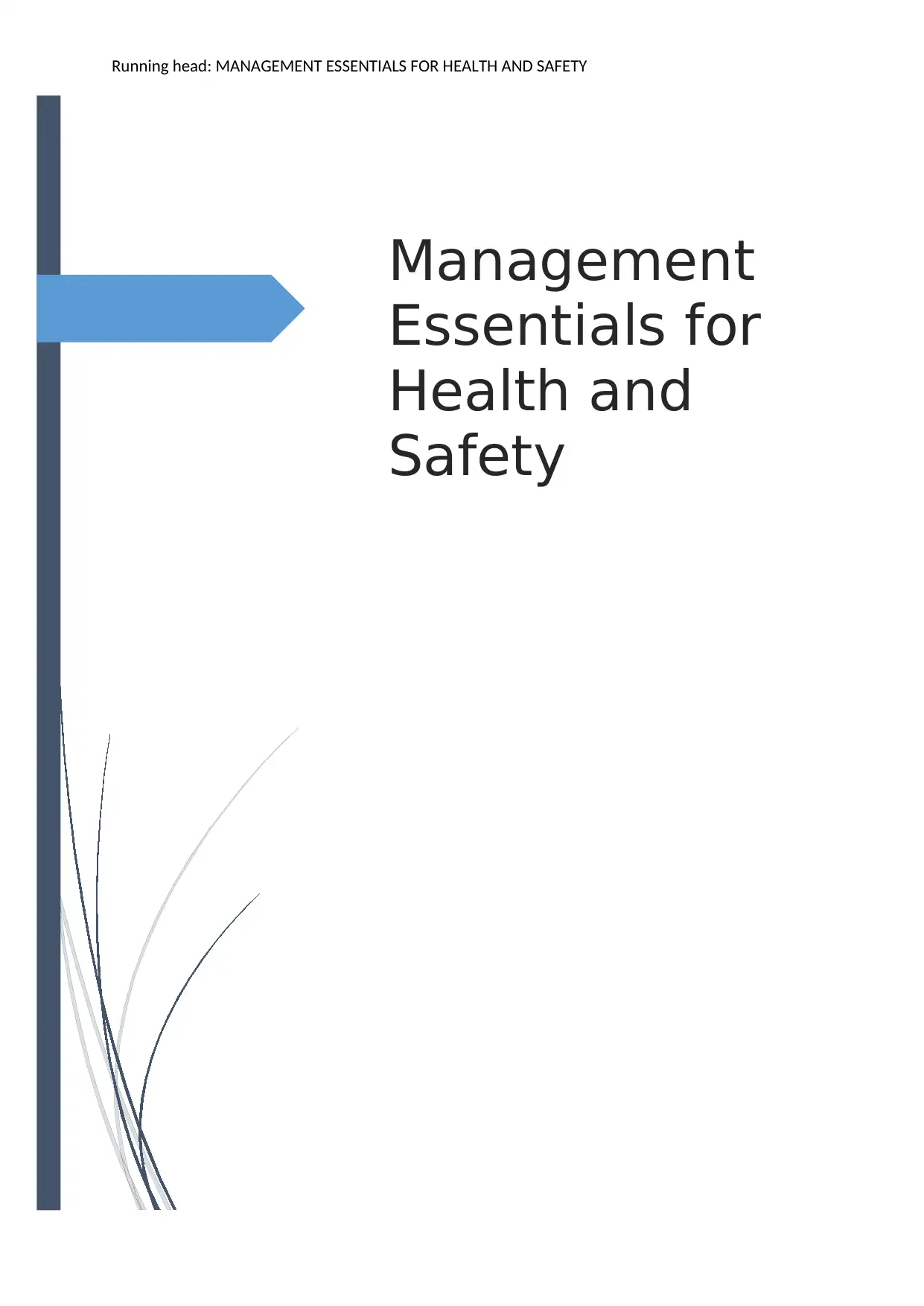
Running head: MANAGEMENT ESSENTIALS FOR HEALTH AND SAFETY
Management
Essentials for
Health and
Safety
Management
Essentials for
Health and
Safety
Secure Best Marks with AI Grader
Need help grading? Try our AI Grader for instant feedback on your assignments.
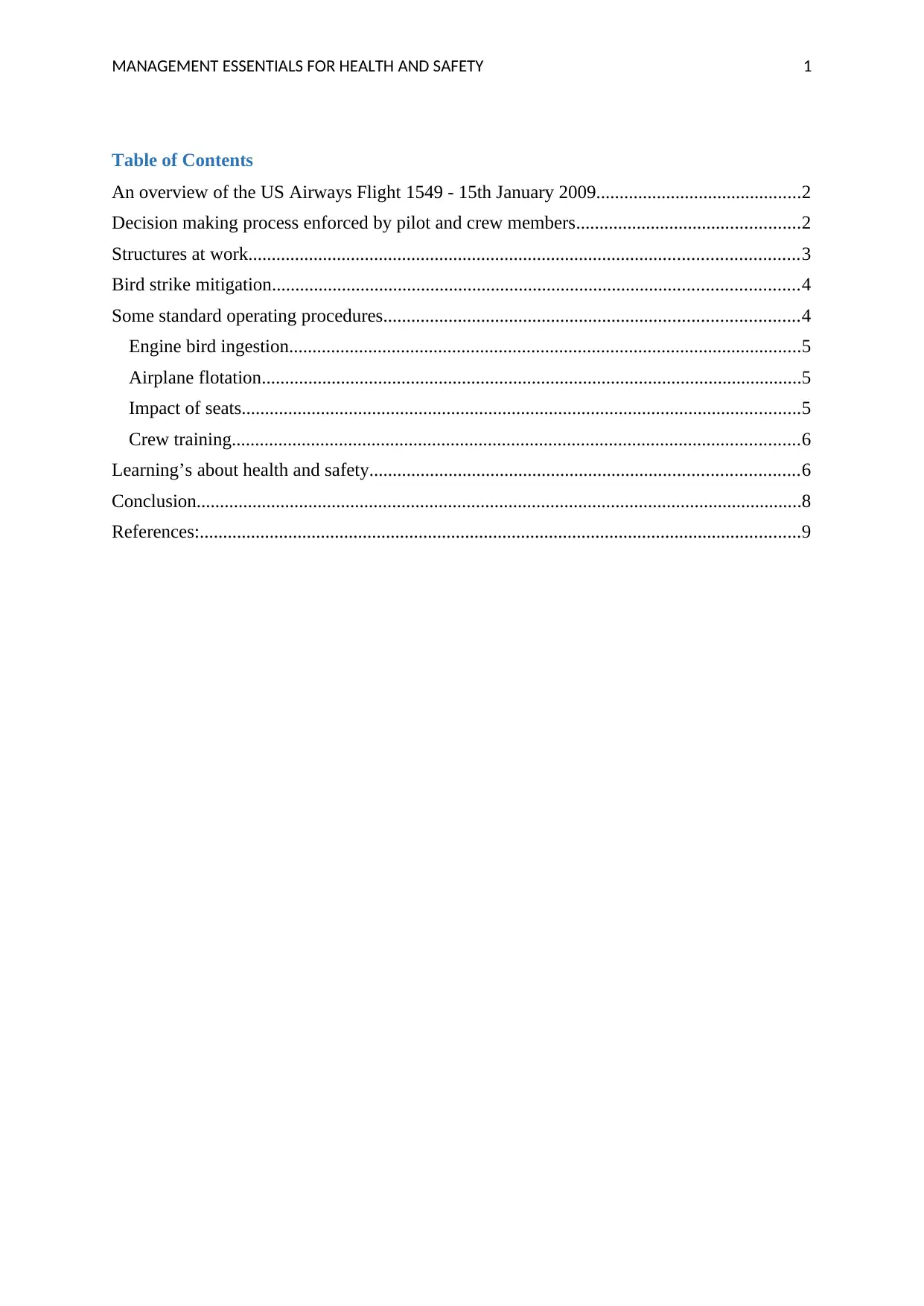
MANAGEMENT ESSENTIALS FOR HEALTH AND SAFETY 1
Table of Contents
An overview of the US Airways Flight 1549 - 15th January 2009............................................2
Decision making process enforced by pilot and crew members................................................2
Structures at work......................................................................................................................3
Bird strike mitigation.................................................................................................................4
Some standard operating procedures.........................................................................................4
Engine bird ingestion..............................................................................................................5
Airplane flotation....................................................................................................................5
Impact of seats........................................................................................................................5
Crew training..........................................................................................................................6
Learning’s about health and safety............................................................................................6
Conclusion..................................................................................................................................8
References:.................................................................................................................................9
Table of Contents
An overview of the US Airways Flight 1549 - 15th January 2009............................................2
Decision making process enforced by pilot and crew members................................................2
Structures at work......................................................................................................................3
Bird strike mitigation.................................................................................................................4
Some standard operating procedures.........................................................................................4
Engine bird ingestion..............................................................................................................5
Airplane flotation....................................................................................................................5
Impact of seats........................................................................................................................5
Crew training..........................................................................................................................6
Learning’s about health and safety............................................................................................6
Conclusion..................................................................................................................................8
References:.................................................................................................................................9
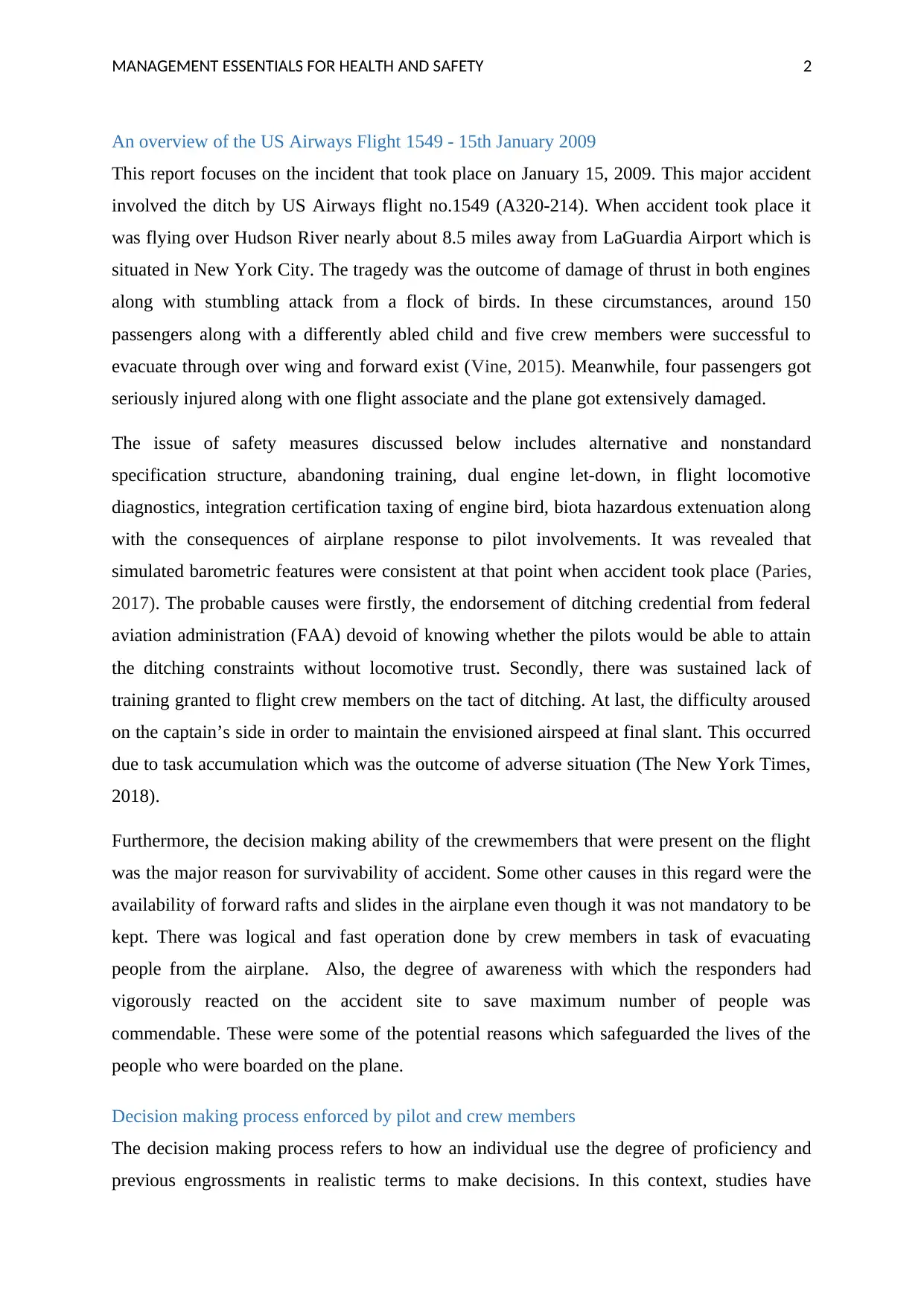
MANAGEMENT ESSENTIALS FOR HEALTH AND SAFETY 2
An overview of the US Airways Flight 1549 - 15th January 2009
This report focuses on the incident that took place on January 15, 2009. This major accident
involved the ditch by US Airways flight no.1549 (A320-214). When accident took place it
was flying over Hudson River nearly about 8.5 miles away from LaGuardia Airport which is
situated in New York City. The tragedy was the outcome of damage of thrust in both engines
along with stumbling attack from a flock of birds. In these circumstances, around 150
passengers along with a differently abled child and five crew members were successful to
evacuate through over wing and forward exist (Vine, 2015). Meanwhile, four passengers got
seriously injured along with one flight associate and the plane got extensively damaged.
The issue of safety measures discussed below includes alternative and nonstandard
specification structure, abandoning training, dual engine let-down, in flight locomotive
diagnostics, integration certification taxing of engine bird, biota hazardous extenuation along
with the consequences of airplane response to pilot involvements. It was revealed that
simulated barometric features were consistent at that point when accident took place (Paries,
2017). The probable causes were firstly, the endorsement of ditching credential from federal
aviation administration (FAA) devoid of knowing whether the pilots would be able to attain
the ditching constraints without locomotive trust. Secondly, there was sustained lack of
training granted to flight crew members on the tact of ditching. At last, the difficulty aroused
on the captain’s side in order to maintain the envisioned airspeed at final slant. This occurred
due to task accumulation which was the outcome of adverse situation (The New York Times,
2018).
Furthermore, the decision making ability of the crewmembers that were present on the flight
was the major reason for survivability of accident. Some other causes in this regard were the
availability of forward rafts and slides in the airplane even though it was not mandatory to be
kept. There was logical and fast operation done by crew members in task of evacuating
people from the airplane. Also, the degree of awareness with which the responders had
vigorously reacted on the accident site to save maximum number of people was
commendable. These were some of the potential reasons which safeguarded the lives of the
people who were boarded on the plane.
Decision making process enforced by pilot and crew members
The decision making process refers to how an individual use the degree of proficiency and
previous engrossments in realistic terms to make decisions. In this context, studies have
An overview of the US Airways Flight 1549 - 15th January 2009
This report focuses on the incident that took place on January 15, 2009. This major accident
involved the ditch by US Airways flight no.1549 (A320-214). When accident took place it
was flying over Hudson River nearly about 8.5 miles away from LaGuardia Airport which is
situated in New York City. The tragedy was the outcome of damage of thrust in both engines
along with stumbling attack from a flock of birds. In these circumstances, around 150
passengers along with a differently abled child and five crew members were successful to
evacuate through over wing and forward exist (Vine, 2015). Meanwhile, four passengers got
seriously injured along with one flight associate and the plane got extensively damaged.
The issue of safety measures discussed below includes alternative and nonstandard
specification structure, abandoning training, dual engine let-down, in flight locomotive
diagnostics, integration certification taxing of engine bird, biota hazardous extenuation along
with the consequences of airplane response to pilot involvements. It was revealed that
simulated barometric features were consistent at that point when accident took place (Paries,
2017). The probable causes were firstly, the endorsement of ditching credential from federal
aviation administration (FAA) devoid of knowing whether the pilots would be able to attain
the ditching constraints without locomotive trust. Secondly, there was sustained lack of
training granted to flight crew members on the tact of ditching. At last, the difficulty aroused
on the captain’s side in order to maintain the envisioned airspeed at final slant. This occurred
due to task accumulation which was the outcome of adverse situation (The New York Times,
2018).
Furthermore, the decision making ability of the crewmembers that were present on the flight
was the major reason for survivability of accident. Some other causes in this regard were the
availability of forward rafts and slides in the airplane even though it was not mandatory to be
kept. There was logical and fast operation done by crew members in task of evacuating
people from the airplane. Also, the degree of awareness with which the responders had
vigorously reacted on the accident site to save maximum number of people was
commendable. These were some of the potential reasons which safeguarded the lives of the
people who were boarded on the plane.
Decision making process enforced by pilot and crew members
The decision making process refers to how an individual use the degree of proficiency and
previous engrossments in realistic terms to make decisions. In this context, studies have
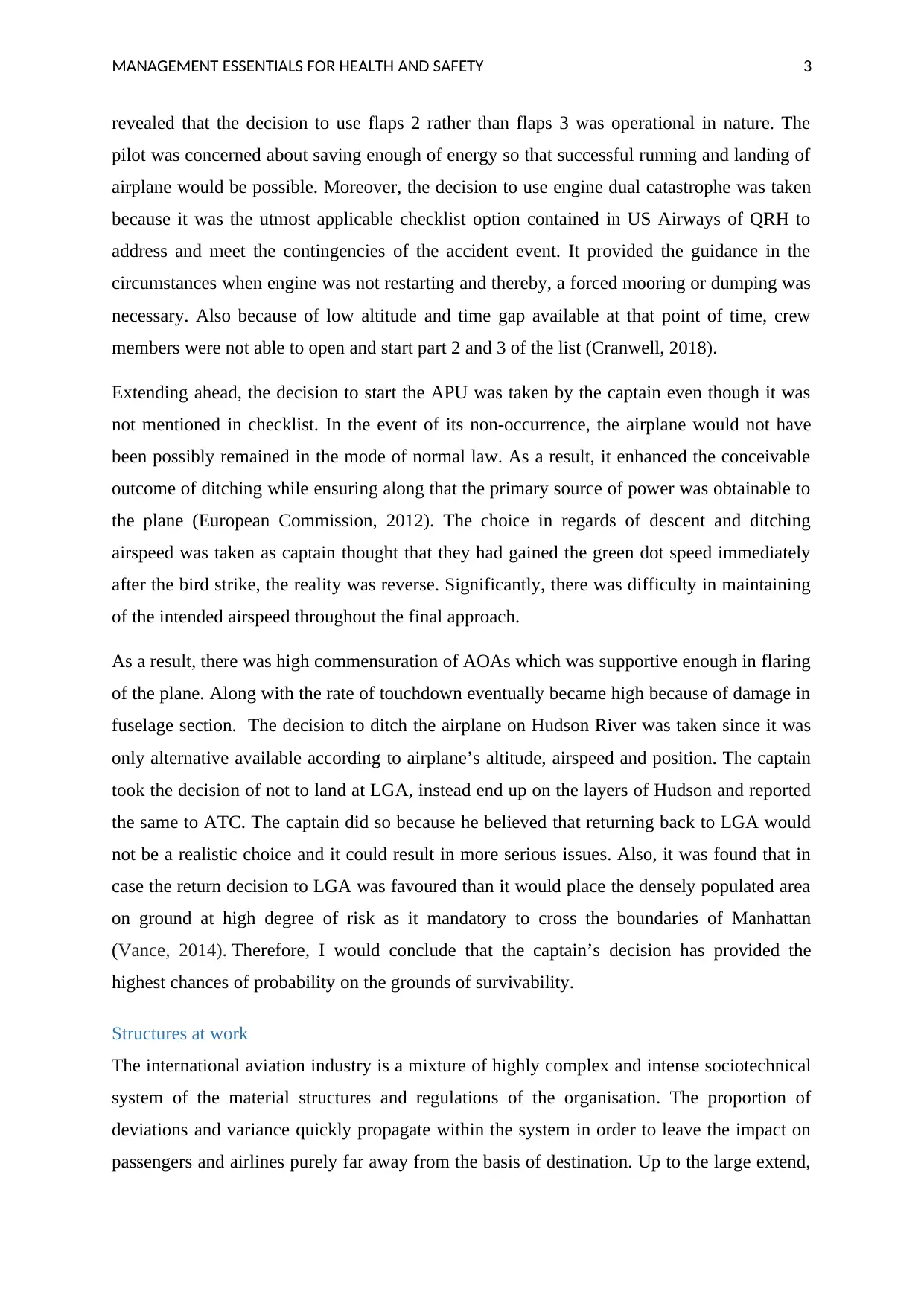
MANAGEMENT ESSENTIALS FOR HEALTH AND SAFETY 3
revealed that the decision to use flaps 2 rather than flaps 3 was operational in nature. The
pilot was concerned about saving enough of energy so that successful running and landing of
airplane would be possible. Moreover, the decision to use engine dual catastrophe was taken
because it was the utmost applicable checklist option contained in US Airways of QRH to
address and meet the contingencies of the accident event. It provided the guidance in the
circumstances when engine was not restarting and thereby, a forced mooring or dumping was
necessary. Also because of low altitude and time gap available at that point of time, crew
members were not able to open and start part 2 and 3 of the list (Cranwell, 2018).
Extending ahead, the decision to start the APU was taken by the captain even though it was
not mentioned in checklist. In the event of its non-occurrence, the airplane would not have
been possibly remained in the mode of normal law. As a result, it enhanced the conceivable
outcome of ditching while ensuring along that the primary source of power was obtainable to
the plane (European Commission, 2012). The choice in regards of descent and ditching
airspeed was taken as captain thought that they had gained the green dot speed immediately
after the bird strike, the reality was reverse. Significantly, there was difficulty in maintaining
of the intended airspeed throughout the final approach.
As a result, there was high commensuration of AOAs which was supportive enough in flaring
of the plane. Along with the rate of touchdown eventually became high because of damage in
fuselage section. The decision to ditch the airplane on Hudson River was taken since it was
only alternative available according to airplane’s altitude, airspeed and position. The captain
took the decision of not to land at LGA, instead end up on the layers of Hudson and reported
the same to ATC. The captain did so because he believed that returning back to LGA would
not be a realistic choice and it could result in more serious issues. Also, it was found that in
case the return decision to LGA was favoured than it would place the densely populated area
on ground at high degree of risk as it mandatory to cross the boundaries of Manhattan
(Vance, 2014). Therefore, I would conclude that the captain’s decision has provided the
highest chances of probability on the grounds of survivability.
Structures at work
The international aviation industry is a mixture of highly complex and intense sociotechnical
system of the material structures and regulations of the organisation. The proportion of
deviations and variance quickly propagate within the system in order to leave the impact on
passengers and airlines purely far away from the basis of destination. Up to the large extend,
revealed that the decision to use flaps 2 rather than flaps 3 was operational in nature. The
pilot was concerned about saving enough of energy so that successful running and landing of
airplane would be possible. Moreover, the decision to use engine dual catastrophe was taken
because it was the utmost applicable checklist option contained in US Airways of QRH to
address and meet the contingencies of the accident event. It provided the guidance in the
circumstances when engine was not restarting and thereby, a forced mooring or dumping was
necessary. Also because of low altitude and time gap available at that point of time, crew
members were not able to open and start part 2 and 3 of the list (Cranwell, 2018).
Extending ahead, the decision to start the APU was taken by the captain even though it was
not mentioned in checklist. In the event of its non-occurrence, the airplane would not have
been possibly remained in the mode of normal law. As a result, it enhanced the conceivable
outcome of ditching while ensuring along that the primary source of power was obtainable to
the plane (European Commission, 2012). The choice in regards of descent and ditching
airspeed was taken as captain thought that they had gained the green dot speed immediately
after the bird strike, the reality was reverse. Significantly, there was difficulty in maintaining
of the intended airspeed throughout the final approach.
As a result, there was high commensuration of AOAs which was supportive enough in flaring
of the plane. Along with the rate of touchdown eventually became high because of damage in
fuselage section. The decision to ditch the airplane on Hudson River was taken since it was
only alternative available according to airplane’s altitude, airspeed and position. The captain
took the decision of not to land at LGA, instead end up on the layers of Hudson and reported
the same to ATC. The captain did so because he believed that returning back to LGA would
not be a realistic choice and it could result in more serious issues. Also, it was found that in
case the return decision to LGA was favoured than it would place the densely populated area
on ground at high degree of risk as it mandatory to cross the boundaries of Manhattan
(Vance, 2014). Therefore, I would conclude that the captain’s decision has provided the
highest chances of probability on the grounds of survivability.
Structures at work
The international aviation industry is a mixture of highly complex and intense sociotechnical
system of the material structures and regulations of the organisation. The proportion of
deviations and variance quickly propagate within the system in order to leave the impact on
passengers and airlines purely far away from the basis of destination. Up to the large extend,
Secure Best Marks with AI Grader
Need help grading? Try our AI Grader for instant feedback on your assignments.
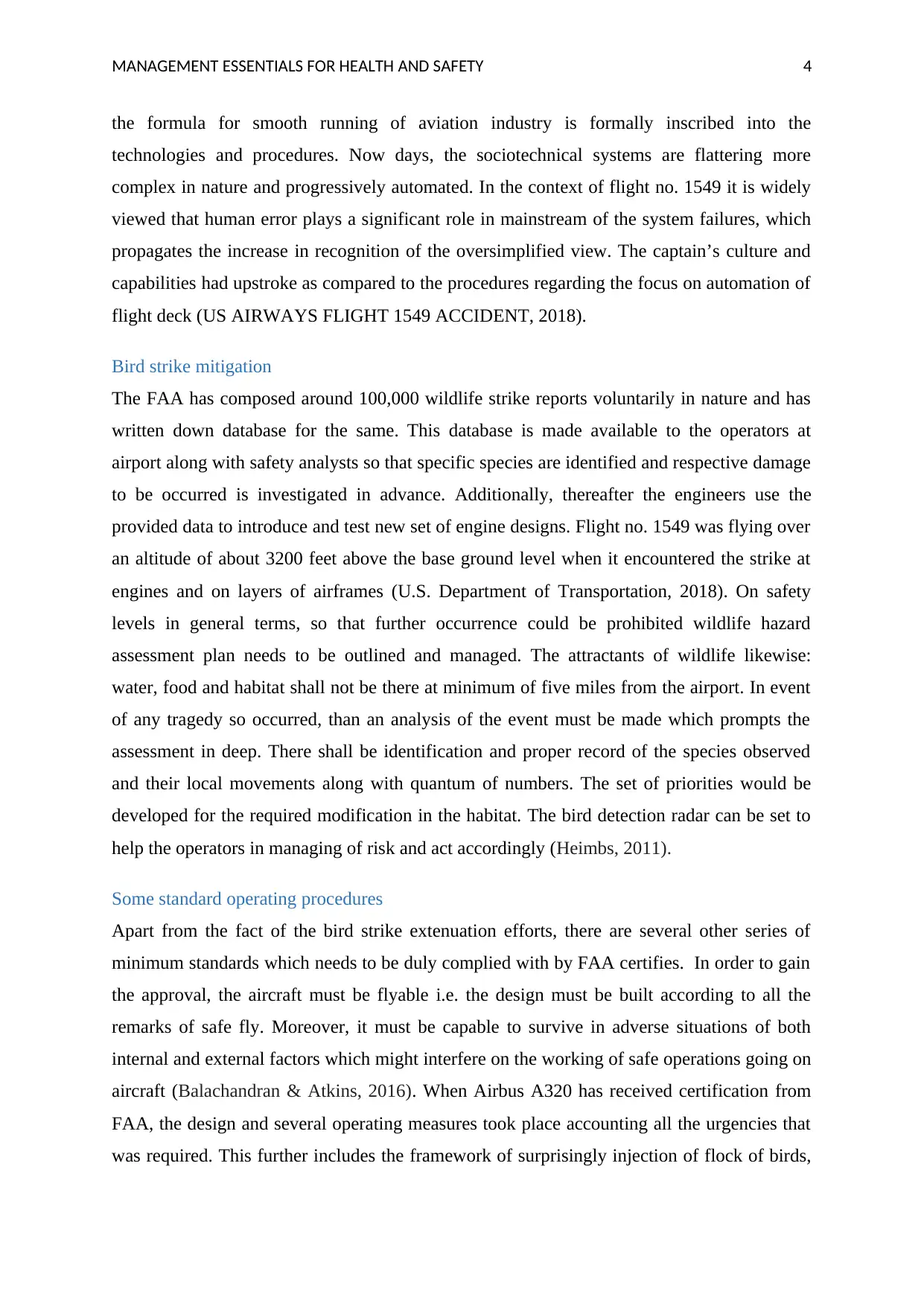
MANAGEMENT ESSENTIALS FOR HEALTH AND SAFETY 4
the formula for smooth running of aviation industry is formally inscribed into the
technologies and procedures. Now days, the sociotechnical systems are flattering more
complex in nature and progressively automated. In the context of flight no. 1549 it is widely
viewed that human error plays a significant role in mainstream of the system failures, which
propagates the increase in recognition of the oversimplified view. The captain’s culture and
capabilities had upstroke as compared to the procedures regarding the focus on automation of
flight deck (US AIRWAYS FLIGHT 1549 ACCIDENT, 2018).
Bird strike mitigation
The FAA has composed around 100,000 wildlife strike reports voluntarily in nature and has
written down database for the same. This database is made available to the operators at
airport along with safety analysts so that specific species are identified and respective damage
to be occurred is investigated in advance. Additionally, thereafter the engineers use the
provided data to introduce and test new set of engine designs. Flight no. 1549 was flying over
an altitude of about 3200 feet above the base ground level when it encountered the strike at
engines and on layers of airframes (U.S. Department of Transportation, 2018). On safety
levels in general terms, so that further occurrence could be prohibited wildlife hazard
assessment plan needs to be outlined and managed. The attractants of wildlife likewise:
water, food and habitat shall not be there at minimum of five miles from the airport. In event
of any tragedy so occurred, than an analysis of the event must be made which prompts the
assessment in deep. There shall be identification and proper record of the species observed
and their local movements along with quantum of numbers. The set of priorities would be
developed for the required modification in the habitat. The bird detection radar can be set to
help the operators in managing of risk and act accordingly (Heimbs, 2011).
Some standard operating procedures
Apart from the fact of the bird strike extenuation efforts, there are several other series of
minimum standards which needs to be duly complied with by FAA certifies. In order to gain
the approval, the aircraft must be flyable i.e. the design must be built according to all the
remarks of safe fly. Moreover, it must be capable to survive in adverse situations of both
internal and external factors which might interfere on the working of safe operations going on
aircraft (Balachandran & Atkins, 2016). When Airbus A320 has received certification from
FAA, the design and several operating measures took place accounting all the urgencies that
was required. This further includes the framework of surprisingly injection of flock of birds,
the formula for smooth running of aviation industry is formally inscribed into the
technologies and procedures. Now days, the sociotechnical systems are flattering more
complex in nature and progressively automated. In the context of flight no. 1549 it is widely
viewed that human error plays a significant role in mainstream of the system failures, which
propagates the increase in recognition of the oversimplified view. The captain’s culture and
capabilities had upstroke as compared to the procedures regarding the focus on automation of
flight deck (US AIRWAYS FLIGHT 1549 ACCIDENT, 2018).
Bird strike mitigation
The FAA has composed around 100,000 wildlife strike reports voluntarily in nature and has
written down database for the same. This database is made available to the operators at
airport along with safety analysts so that specific species are identified and respective damage
to be occurred is investigated in advance. Additionally, thereafter the engineers use the
provided data to introduce and test new set of engine designs. Flight no. 1549 was flying over
an altitude of about 3200 feet above the base ground level when it encountered the strike at
engines and on layers of airframes (U.S. Department of Transportation, 2018). On safety
levels in general terms, so that further occurrence could be prohibited wildlife hazard
assessment plan needs to be outlined and managed. The attractants of wildlife likewise:
water, food and habitat shall not be there at minimum of five miles from the airport. In event
of any tragedy so occurred, than an analysis of the event must be made which prompts the
assessment in deep. There shall be identification and proper record of the species observed
and their local movements along with quantum of numbers. The set of priorities would be
developed for the required modification in the habitat. The bird detection radar can be set to
help the operators in managing of risk and act accordingly (Heimbs, 2011).
Some standard operating procedures
Apart from the fact of the bird strike extenuation efforts, there are several other series of
minimum standards which needs to be duly complied with by FAA certifies. In order to gain
the approval, the aircraft must be flyable i.e. the design must be built according to all the
remarks of safe fly. Moreover, it must be capable to survive in adverse situations of both
internal and external factors which might interfere on the working of safe operations going on
aircraft (Balachandran & Atkins, 2016). When Airbus A320 has received certification from
FAA, the design and several operating measures took place accounting all the urgencies that
was required. This further includes the framework of surprisingly injection of flock of birds,
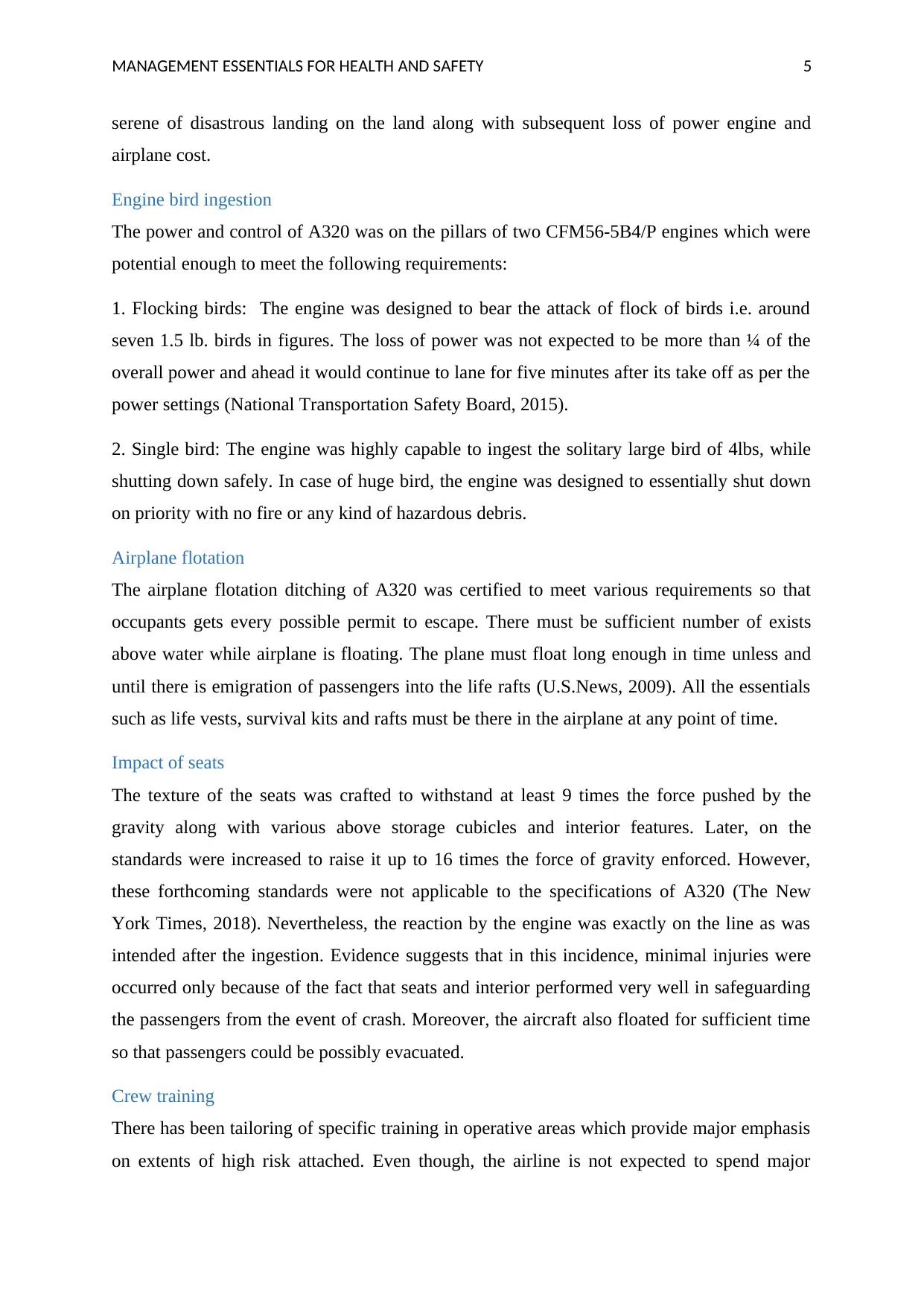
MANAGEMENT ESSENTIALS FOR HEALTH AND SAFETY 5
serene of disastrous landing on the land along with subsequent loss of power engine and
airplane cost.
Engine bird ingestion
The power and control of A320 was on the pillars of two CFM56-5B4/P engines which were
potential enough to meet the following requirements:
1. Flocking birds: The engine was designed to bear the attack of flock of birds i.e. around
seven 1.5 lb. birds in figures. The loss of power was not expected to be more than ¼ of the
overall power and ahead it would continue to lane for five minutes after its take off as per the
power settings (National Transportation Safety Board, 2015).
2. Single bird: The engine was highly capable to ingest the solitary large bird of 4lbs, while
shutting down safely. In case of huge bird, the engine was designed to essentially shut down
on priority with no fire or any kind of hazardous debris.
Airplane flotation
The airplane flotation ditching of A320 was certified to meet various requirements so that
occupants gets every possible permit to escape. There must be sufficient number of exists
above water while airplane is floating. The plane must float long enough in time unless and
until there is emigration of passengers into the life rafts (U.S.News, 2009). All the essentials
such as life vests, survival kits and rafts must be there in the airplane at any point of time.
Impact of seats
The texture of the seats was crafted to withstand at least 9 times the force pushed by the
gravity along with various above storage cubicles and interior features. Later, on the
standards were increased to raise it up to 16 times the force of gravity enforced. However,
these forthcoming standards were not applicable to the specifications of A320 (The New
York Times, 2018). Nevertheless, the reaction by the engine was exactly on the line as was
intended after the ingestion. Evidence suggests that in this incidence, minimal injuries were
occurred only because of the fact that seats and interior performed very well in safeguarding
the passengers from the event of crash. Moreover, the aircraft also floated for sufficient time
so that passengers could be possibly evacuated.
Crew training
There has been tailoring of specific training in operative areas which provide major emphasis
on extents of high risk attached. Even though, the airline is not expected to spend major
serene of disastrous landing on the land along with subsequent loss of power engine and
airplane cost.
Engine bird ingestion
The power and control of A320 was on the pillars of two CFM56-5B4/P engines which were
potential enough to meet the following requirements:
1. Flocking birds: The engine was designed to bear the attack of flock of birds i.e. around
seven 1.5 lb. birds in figures. The loss of power was not expected to be more than ¼ of the
overall power and ahead it would continue to lane for five minutes after its take off as per the
power settings (National Transportation Safety Board, 2015).
2. Single bird: The engine was highly capable to ingest the solitary large bird of 4lbs, while
shutting down safely. In case of huge bird, the engine was designed to essentially shut down
on priority with no fire or any kind of hazardous debris.
Airplane flotation
The airplane flotation ditching of A320 was certified to meet various requirements so that
occupants gets every possible permit to escape. There must be sufficient number of exists
above water while airplane is floating. The plane must float long enough in time unless and
until there is emigration of passengers into the life rafts (U.S.News, 2009). All the essentials
such as life vests, survival kits and rafts must be there in the airplane at any point of time.
Impact of seats
The texture of the seats was crafted to withstand at least 9 times the force pushed by the
gravity along with various above storage cubicles and interior features. Later, on the
standards were increased to raise it up to 16 times the force of gravity enforced. However,
these forthcoming standards were not applicable to the specifications of A320 (The New
York Times, 2018). Nevertheless, the reaction by the engine was exactly on the line as was
intended after the ingestion. Evidence suggests that in this incidence, minimal injuries were
occurred only because of the fact that seats and interior performed very well in safeguarding
the passengers from the event of crash. Moreover, the aircraft also floated for sufficient time
so that passengers could be possibly evacuated.
Crew training
There has been tailoring of specific training in operative areas which provide major emphasis
on extents of high risk attached. Even though, the airline is not expected to spend major
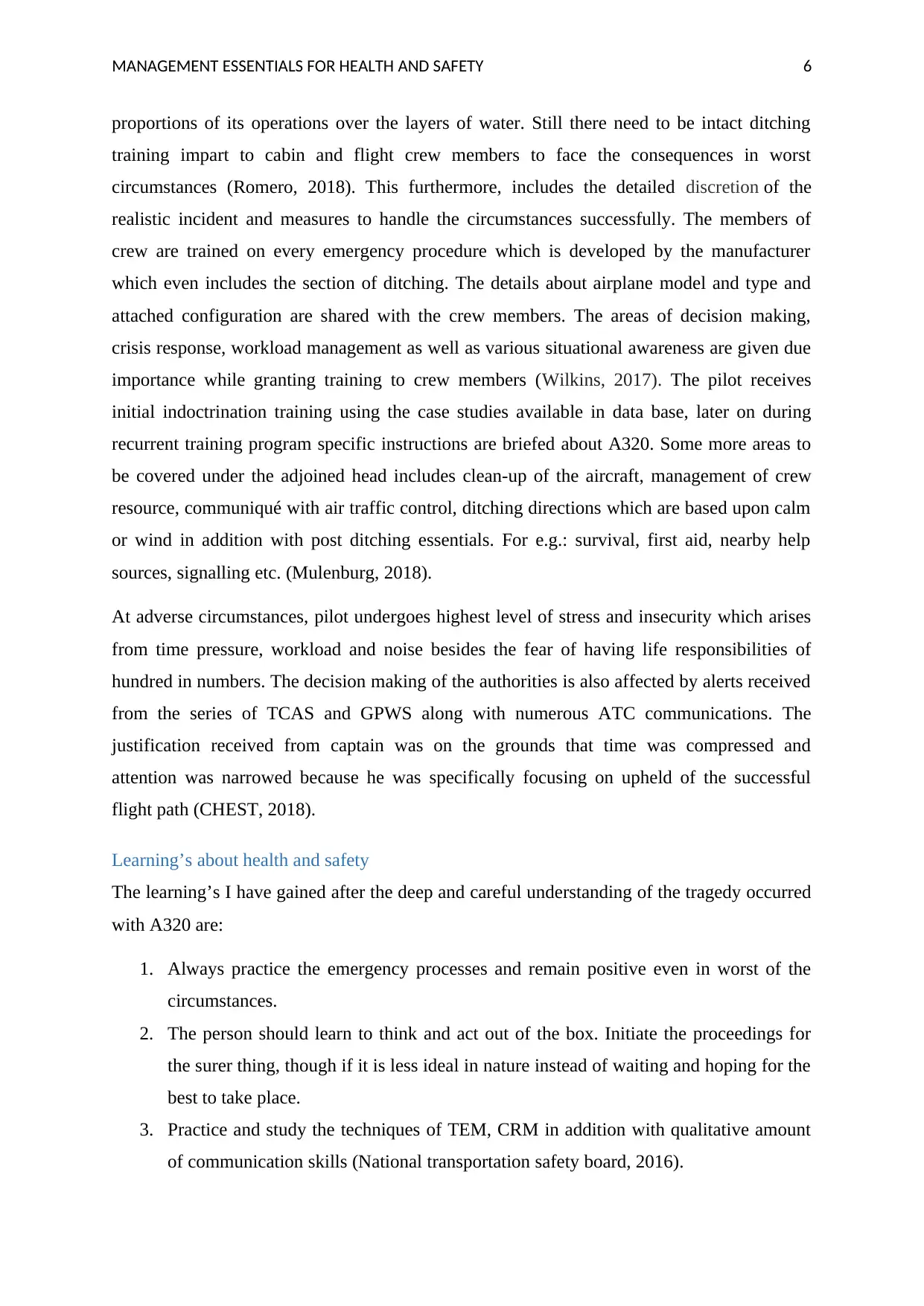
MANAGEMENT ESSENTIALS FOR HEALTH AND SAFETY 6
proportions of its operations over the layers of water. Still there need to be intact ditching
training impart to cabin and flight crew members to face the consequences in worst
circumstances (Romero, 2018). This furthermore, includes the detailed discretion of the
realistic incident and measures to handle the circumstances successfully. The members of
crew are trained on every emergency procedure which is developed by the manufacturer
which even includes the section of ditching. The details about airplane model and type and
attached configuration are shared with the crew members. The areas of decision making,
crisis response, workload management as well as various situational awareness are given due
importance while granting training to crew members (Wilkins, 2017). The pilot receives
initial indoctrination training using the case studies available in data base, later on during
recurrent training program specific instructions are briefed about A320. Some more areas to
be covered under the adjoined head includes clean-up of the aircraft, management of crew
resource, communiqué with air traffic control, ditching directions which are based upon calm
or wind in addition with post ditching essentials. For e.g.: survival, first aid, nearby help
sources, signalling etc. (Mulenburg, 2018).
At adverse circumstances, pilot undergoes highest level of stress and insecurity which arises
from time pressure, workload and noise besides the fear of having life responsibilities of
hundred in numbers. The decision making of the authorities is also affected by alerts received
from the series of TCAS and GPWS along with numerous ATC communications. The
justification received from captain was on the grounds that time was compressed and
attention was narrowed because he was specifically focusing on upheld of the successful
flight path (CHEST, 2018).
Learning’s about health and safety
The learning’s I have gained after the deep and careful understanding of the tragedy occurred
with A320 are:
1. Always practice the emergency processes and remain positive even in worst of the
circumstances.
2. The person should learn to think and act out of the box. Initiate the proceedings for
the surer thing, though if it is less ideal in nature instead of waiting and hoping for the
best to take place.
3. Practice and study the techniques of TEM, CRM in addition with qualitative amount
of communication skills (National transportation safety board, 2016).
proportions of its operations over the layers of water. Still there need to be intact ditching
training impart to cabin and flight crew members to face the consequences in worst
circumstances (Romero, 2018). This furthermore, includes the detailed discretion of the
realistic incident and measures to handle the circumstances successfully. The members of
crew are trained on every emergency procedure which is developed by the manufacturer
which even includes the section of ditching. The details about airplane model and type and
attached configuration are shared with the crew members. The areas of decision making,
crisis response, workload management as well as various situational awareness are given due
importance while granting training to crew members (Wilkins, 2017). The pilot receives
initial indoctrination training using the case studies available in data base, later on during
recurrent training program specific instructions are briefed about A320. Some more areas to
be covered under the adjoined head includes clean-up of the aircraft, management of crew
resource, communiqué with air traffic control, ditching directions which are based upon calm
or wind in addition with post ditching essentials. For e.g.: survival, first aid, nearby help
sources, signalling etc. (Mulenburg, 2018).
At adverse circumstances, pilot undergoes highest level of stress and insecurity which arises
from time pressure, workload and noise besides the fear of having life responsibilities of
hundred in numbers. The decision making of the authorities is also affected by alerts received
from the series of TCAS and GPWS along with numerous ATC communications. The
justification received from captain was on the grounds that time was compressed and
attention was narrowed because he was specifically focusing on upheld of the successful
flight path (CHEST, 2018).
Learning’s about health and safety
The learning’s I have gained after the deep and careful understanding of the tragedy occurred
with A320 are:
1. Always practice the emergency processes and remain positive even in worst of the
circumstances.
2. The person should learn to think and act out of the box. Initiate the proceedings for
the surer thing, though if it is less ideal in nature instead of waiting and hoping for the
best to take place.
3. Practice and study the techniques of TEM, CRM in addition with qualitative amount
of communication skills (National transportation safety board, 2016).
Paraphrase This Document
Need a fresh take? Get an instant paraphrase of this document with our AI Paraphraser
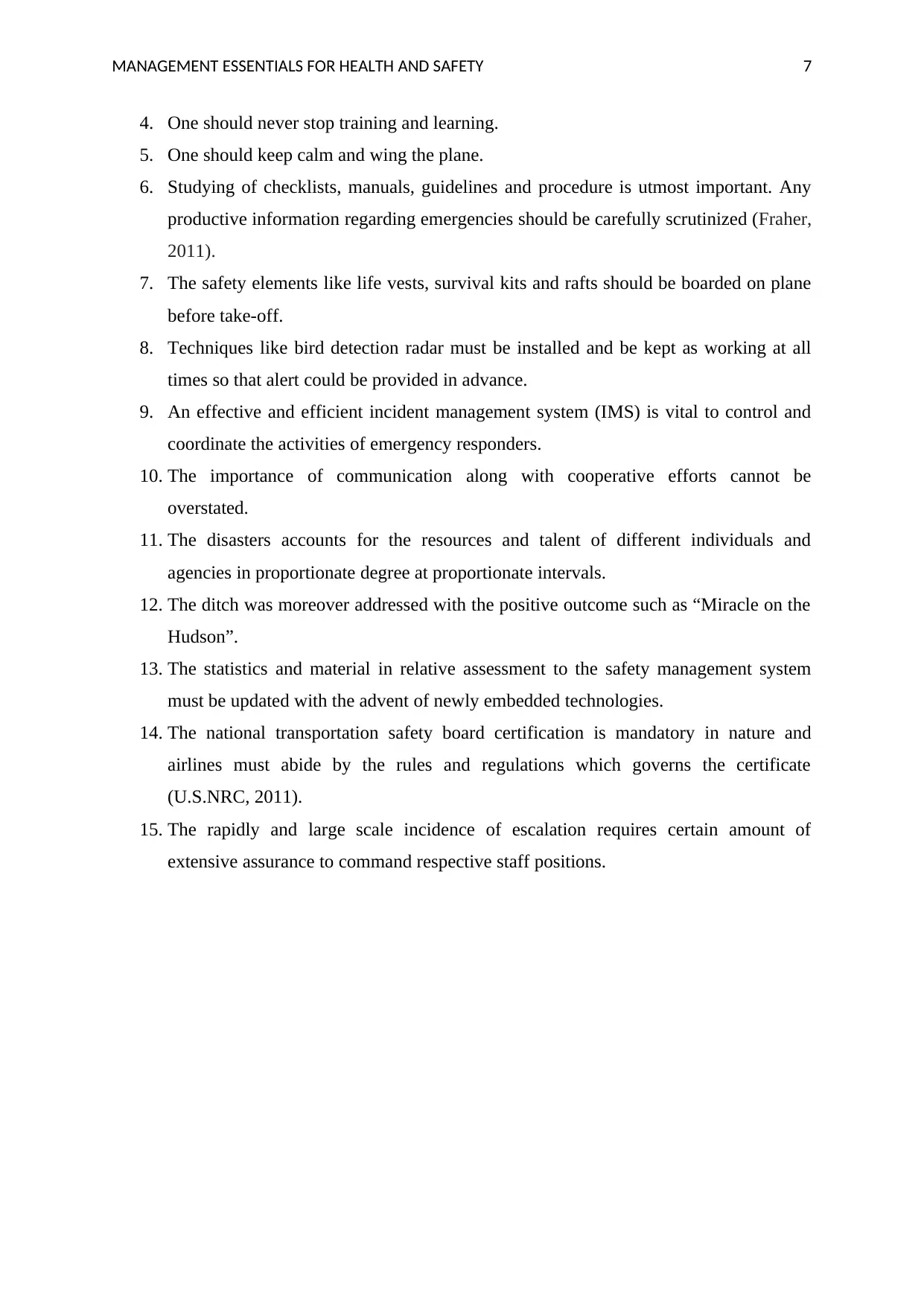
MANAGEMENT ESSENTIALS FOR HEALTH AND SAFETY 7
4. One should never stop training and learning.
5. One should keep calm and wing the plane.
6. Studying of checklists, manuals, guidelines and procedure is utmost important. Any
productive information regarding emergencies should be carefully scrutinized (Fraher,
2011).
7. The safety elements like life vests, survival kits and rafts should be boarded on plane
before take-off.
8. Techniques like bird detection radar must be installed and be kept as working at all
times so that alert could be provided in advance.
9. An effective and efficient incident management system (IMS) is vital to control and
coordinate the activities of emergency responders.
10. The importance of communication along with cooperative efforts cannot be
overstated.
11. The disasters accounts for the resources and talent of different individuals and
agencies in proportionate degree at proportionate intervals.
12. The ditch was moreover addressed with the positive outcome such as “Miracle on the
Hudson”.
13. The statistics and material in relative assessment to the safety management system
must be updated with the advent of newly embedded technologies.
14. The national transportation safety board certification is mandatory in nature and
airlines must abide by the rules and regulations which governs the certificate
(U.S.NRC, 2011).
15. The rapidly and large scale incidence of escalation requires certain amount of
extensive assurance to command respective staff positions.
4. One should never stop training and learning.
5. One should keep calm and wing the plane.
6. Studying of checklists, manuals, guidelines and procedure is utmost important. Any
productive information regarding emergencies should be carefully scrutinized (Fraher,
2011).
7. The safety elements like life vests, survival kits and rafts should be boarded on plane
before take-off.
8. Techniques like bird detection radar must be installed and be kept as working at all
times so that alert could be provided in advance.
9. An effective and efficient incident management system (IMS) is vital to control and
coordinate the activities of emergency responders.
10. The importance of communication along with cooperative efforts cannot be
overstated.
11. The disasters accounts for the resources and talent of different individuals and
agencies in proportionate degree at proportionate intervals.
12. The ditch was moreover addressed with the positive outcome such as “Miracle on the
Hudson”.
13. The statistics and material in relative assessment to the safety management system
must be updated with the advent of newly embedded technologies.
14. The national transportation safety board certification is mandatory in nature and
airlines must abide by the rules and regulations which governs the certificate
(U.S.NRC, 2011).
15. The rapidly and large scale incidence of escalation requires certain amount of
extensive assurance to command respective staff positions.
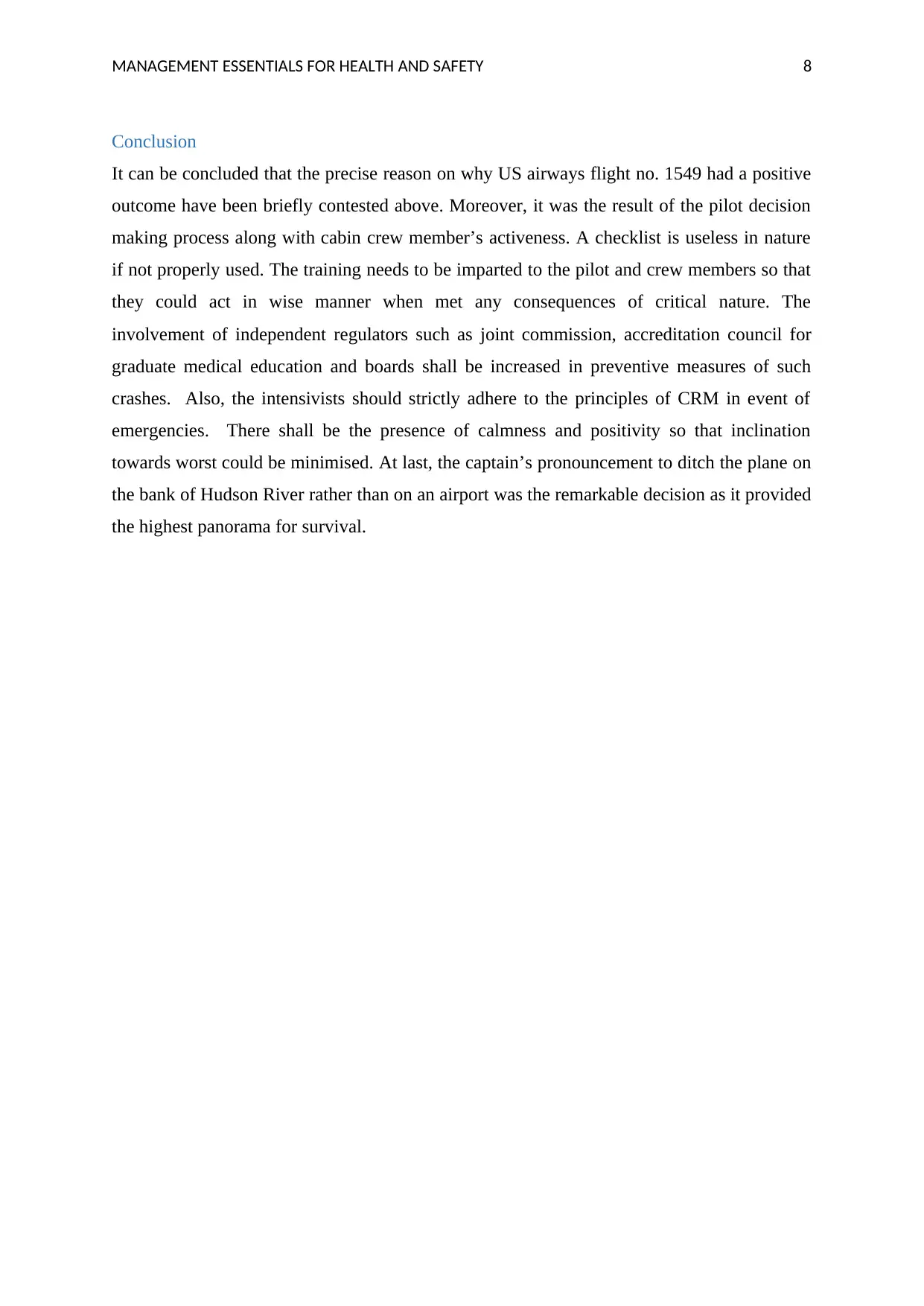
MANAGEMENT ESSENTIALS FOR HEALTH AND SAFETY 8
Conclusion
It can be concluded that the precise reason on why US airways flight no. 1549 had a positive
outcome have been briefly contested above. Moreover, it was the result of the pilot decision
making process along with cabin crew member’s activeness. A checklist is useless in nature
if not properly used. The training needs to be imparted to the pilot and crew members so that
they could act in wise manner when met any consequences of critical nature. The
involvement of independent regulators such as joint commission, accreditation council for
graduate medical education and boards shall be increased in preventive measures of such
crashes. Also, the intensivists should strictly adhere to the principles of CRM in event of
emergencies. There shall be the presence of calmness and positivity so that inclination
towards worst could be minimised. At last, the captain’s pronouncement to ditch the plane on
the bank of Hudson River rather than on an airport was the remarkable decision as it provided
the highest panorama for survival.
Conclusion
It can be concluded that the precise reason on why US airways flight no. 1549 had a positive
outcome have been briefly contested above. Moreover, it was the result of the pilot decision
making process along with cabin crew member’s activeness. A checklist is useless in nature
if not properly used. The training needs to be imparted to the pilot and crew members so that
they could act in wise manner when met any consequences of critical nature. The
involvement of independent regulators such as joint commission, accreditation council for
graduate medical education and boards shall be increased in preventive measures of such
crashes. Also, the intensivists should strictly adhere to the principles of CRM in event of
emergencies. There shall be the presence of calmness and positivity so that inclination
towards worst could be minimised. At last, the captain’s pronouncement to ditch the plane on
the bank of Hudson River rather than on an airport was the remarkable decision as it provided
the highest panorama for survival.
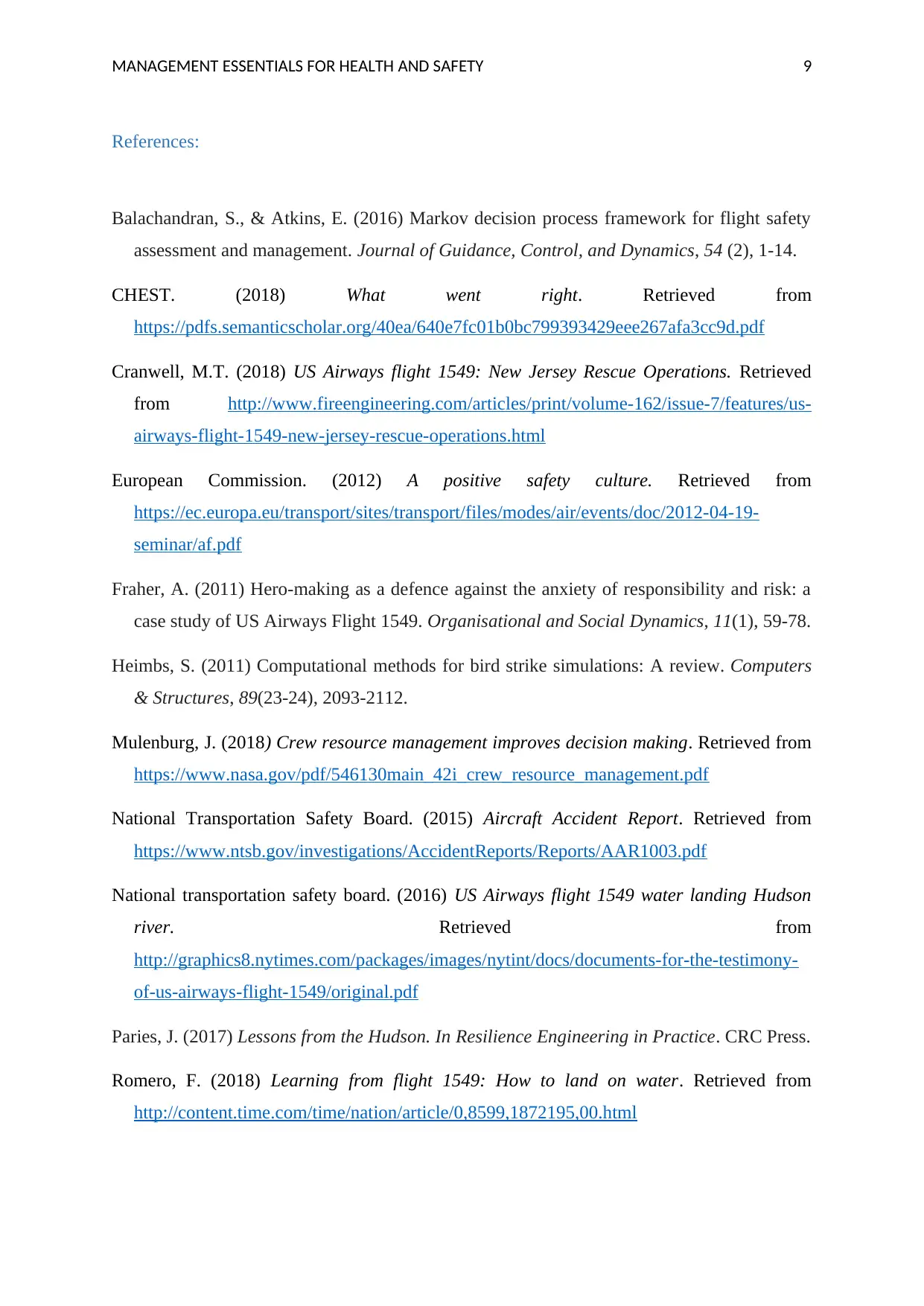
MANAGEMENT ESSENTIALS FOR HEALTH AND SAFETY 9
References:
Balachandran, S., & Atkins, E. (2016) Markov decision process framework for flight safety
assessment and management. Journal of Guidance, Control, and Dynamics, 54 (2), 1-14.
CHEST. (2018) What went right. Retrieved from
https://pdfs.semanticscholar.org/40ea/640e7fc01b0bc799393429eee267afa3cc9d.pdf
Cranwell, M.T. (2018) US Airways flight 1549: New Jersey Rescue Operations. Retrieved
from http://www.fireengineering.com/articles/print/volume-162/issue-7/features/us-
airways-flight-1549-new-jersey-rescue-operations.html
European Commission. (2012) A positive safety culture. Retrieved from
https://ec.europa.eu/transport/sites/transport/files/modes/air/events/doc/2012-04-19-
seminar/af.pdf
Fraher, A. (2011) Hero-making as a defence against the anxiety of responsibility and risk: a
case study of US Airways Flight 1549. Organisational and Social Dynamics, 11(1), 59-78.
Heimbs, S. (2011) Computational methods for bird strike simulations: A review. Computers
& Structures, 89(23-24), 2093-2112.
Mulenburg, J. (2018) Crew resource management improves decision making. Retrieved from
https://www.nasa.gov/pdf/546130main_42i_crew_resource_management.pdf
National Transportation Safety Board. (2015) Aircraft Accident Report. Retrieved from
https://www.ntsb.gov/investigations/AccidentReports/Reports/AAR1003.pdf
National transportation safety board. (2016) US Airways flight 1549 water landing Hudson
river. Retrieved from
http://graphics8.nytimes.com/packages/images/nytint/docs/documents-for-the-testimony-
of-us-airways-flight-1549/original.pdf
Paries, J. (2017) Lessons from the Hudson. In Resilience Engineering in Practice. CRC Press.
Romero, F. (2018) Learning from flight 1549: How to land on water. Retrieved from
http://content.time.com/time/nation/article/0,8599,1872195,00.html
References:
Balachandran, S., & Atkins, E. (2016) Markov decision process framework for flight safety
assessment and management. Journal of Guidance, Control, and Dynamics, 54 (2), 1-14.
CHEST. (2018) What went right. Retrieved from
https://pdfs.semanticscholar.org/40ea/640e7fc01b0bc799393429eee267afa3cc9d.pdf
Cranwell, M.T. (2018) US Airways flight 1549: New Jersey Rescue Operations. Retrieved
from http://www.fireengineering.com/articles/print/volume-162/issue-7/features/us-
airways-flight-1549-new-jersey-rescue-operations.html
European Commission. (2012) A positive safety culture. Retrieved from
https://ec.europa.eu/transport/sites/transport/files/modes/air/events/doc/2012-04-19-
seminar/af.pdf
Fraher, A. (2011) Hero-making as a defence against the anxiety of responsibility and risk: a
case study of US Airways Flight 1549. Organisational and Social Dynamics, 11(1), 59-78.
Heimbs, S. (2011) Computational methods for bird strike simulations: A review. Computers
& Structures, 89(23-24), 2093-2112.
Mulenburg, J. (2018) Crew resource management improves decision making. Retrieved from
https://www.nasa.gov/pdf/546130main_42i_crew_resource_management.pdf
National Transportation Safety Board. (2015) Aircraft Accident Report. Retrieved from
https://www.ntsb.gov/investigations/AccidentReports/Reports/AAR1003.pdf
National transportation safety board. (2016) US Airways flight 1549 water landing Hudson
river. Retrieved from
http://graphics8.nytimes.com/packages/images/nytint/docs/documents-for-the-testimony-
of-us-airways-flight-1549/original.pdf
Paries, J. (2017) Lessons from the Hudson. In Resilience Engineering in Practice. CRC Press.
Romero, F. (2018) Learning from flight 1549: How to land on water. Retrieved from
http://content.time.com/time/nation/article/0,8599,1872195,00.html
Secure Best Marks with AI Grader
Need help grading? Try our AI Grader for instant feedback on your assignments.
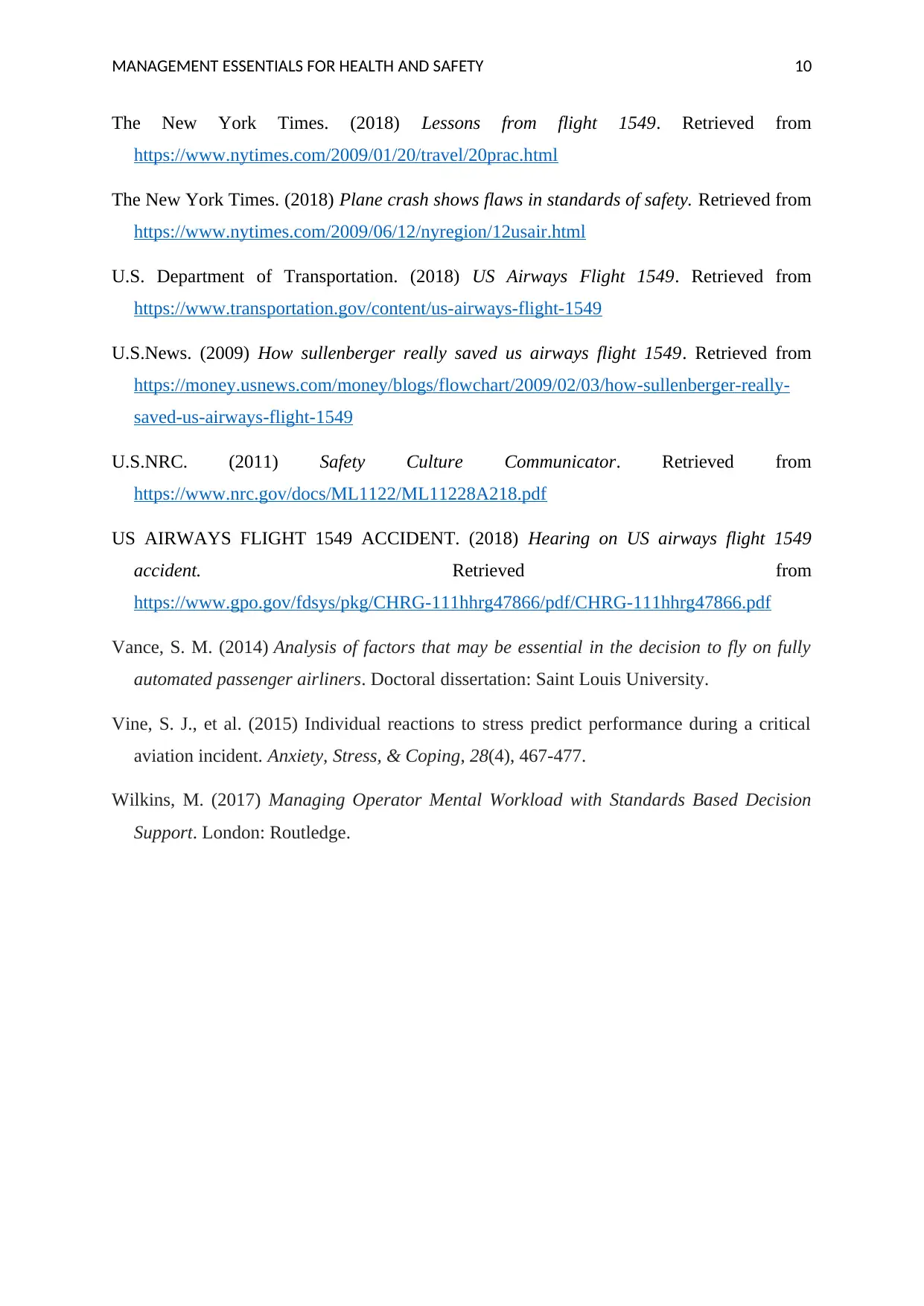
MANAGEMENT ESSENTIALS FOR HEALTH AND SAFETY 10
The New York Times. (2018) Lessons from flight 1549. Retrieved from
https://www.nytimes.com/2009/01/20/travel/20prac.html
The New York Times. (2018) Plane crash shows flaws in standards of safety. Retrieved from
https://www.nytimes.com/2009/06/12/nyregion/12usair.html
U.S. Department of Transportation. (2018) US Airways Flight 1549. Retrieved from
https://www.transportation.gov/content/us-airways-flight-1549
U.S.News. (2009) How sullenberger really saved us airways flight 1549. Retrieved from
https://money.usnews.com/money/blogs/flowchart/2009/02/03/how-sullenberger-really-
saved-us-airways-flight-1549
U.S.NRC. (2011) Safety Culture Communicator. Retrieved from
https://www.nrc.gov/docs/ML1122/ML11228A218.pdf
US AIRWAYS FLIGHT 1549 ACCIDENT. (2018) Hearing on US airways flight 1549
accident. Retrieved from
https://www.gpo.gov/fdsys/pkg/CHRG-111hhrg47866/pdf/CHRG-111hhrg47866.pdf
Vance, S. M. (2014) Analysis of factors that may be essential in the decision to fly on fully
automated passenger airliners. Doctoral dissertation: Saint Louis University.
Vine, S. J., et al. (2015) Individual reactions to stress predict performance during a critical
aviation incident. Anxiety, Stress, & Coping, 28(4), 467-477.
Wilkins, M. (2017) Managing Operator Mental Workload with Standards Based Decision
Support. London: Routledge.
The New York Times. (2018) Lessons from flight 1549. Retrieved from
https://www.nytimes.com/2009/01/20/travel/20prac.html
The New York Times. (2018) Plane crash shows flaws in standards of safety. Retrieved from
https://www.nytimes.com/2009/06/12/nyregion/12usair.html
U.S. Department of Transportation. (2018) US Airways Flight 1549. Retrieved from
https://www.transportation.gov/content/us-airways-flight-1549
U.S.News. (2009) How sullenberger really saved us airways flight 1549. Retrieved from
https://money.usnews.com/money/blogs/flowchart/2009/02/03/how-sullenberger-really-
saved-us-airways-flight-1549
U.S.NRC. (2011) Safety Culture Communicator. Retrieved from
https://www.nrc.gov/docs/ML1122/ML11228A218.pdf
US AIRWAYS FLIGHT 1549 ACCIDENT. (2018) Hearing on US airways flight 1549
accident. Retrieved from
https://www.gpo.gov/fdsys/pkg/CHRG-111hhrg47866/pdf/CHRG-111hhrg47866.pdf
Vance, S. M. (2014) Analysis of factors that may be essential in the decision to fly on fully
automated passenger airliners. Doctoral dissertation: Saint Louis University.
Vine, S. J., et al. (2015) Individual reactions to stress predict performance during a critical
aviation incident. Anxiety, Stress, & Coping, 28(4), 467-477.
Wilkins, M. (2017) Managing Operator Mental Workload with Standards Based Decision
Support. London: Routledge.
1 out of 11
Your All-in-One AI-Powered Toolkit for Academic Success.
+13062052269
info@desklib.com
Available 24*7 on WhatsApp / Email
![[object Object]](/_next/static/media/star-bottom.7253800d.svg)
Unlock your academic potential
© 2024 | Zucol Services PVT LTD | All rights reserved.

